from
Behind the French Menu
by
Bryan G. Newman
behindthefrenchmenu@gmail.com
Jerusalem artichokes ready for the chef.
www.flickr.com/photos/30478819@N08/51114490763/
The Jerusalem artichoke or sunchoke has no connection to other artichokes.
The Jerusalem artichoke is a tuber. It is not related to the globe artichoke, whose family includes the cardoon and thistles. The Jerusalem artichoke or sunchoke is higher up the social ladder as it is related to the sunflower. We may pick the flowers, but the part we eat is the underground tuber. Raw it looks rather like ginger root, to which it is not related.
The taste of the Jerusalem artichoke.
Uncooked Jerusalem artichokes have a crunchy, white flesh with a nutty, sweet flavor and are often part of a salad. When cooked, Jerusalem artichokes make excellent soups and may be served mashed or fried as a garnish.
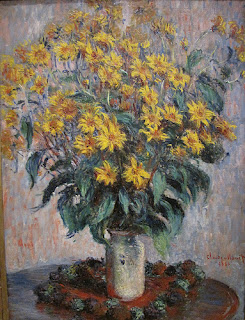
Jerusalem artichoke flowers.
Painted by Claude Monet (1880).
National Art Gallery Washington DC.
Photograph courtesy of
EdUthman
www.flickr.com/photos/euthman/4089107324/
The Jerusalem artichoke on French menus:
Chapon Contisé de Truffes, Châtaignes et
Artichauts de Jérusalem – A capon, that is a rooster, a
cockerel, castrated as a chick and then fattened. Here the capon, the star of
the show, will weigh at least 2.50 kilos (5.50lbs). It is cooked with truffles, chestnuts, and the
Jerusalem artichoke cut into small pieces and inserted into slits, contisé in
French; so they add flavor as the capon cooks. Capons have tender meat and are
usually roasted. You will be served part of the breast or portion of a leg; a
capon is a large bird.
Carré d'Agneau Rôti en Légère Croûte d'Ail, Artichauts de
Jérusalem en Purée, Légumes Frais et Jus - A rack of lamb slowly
roasted with a covering of garlic and
accompanied by fresh vegetables and the natural cooking juices.
A croute is a covering, and a croûte d'ail is a
garlic-flavored covering. The garlic will have been boiled to remove any heavy
garlic taste. Then, before roasting, the lamb is covered with a lightly
flavored garlic covering made by combining mashed garlic with mashed potatoes
or pastry.
Filet de Rouget Barbet, Artichaut de Jérusalem - A filet of red mullet served with the Jerusalem artichoke.
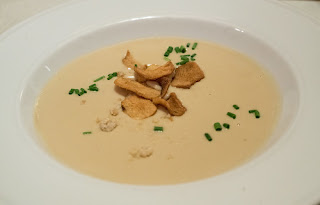
Jerusalem artichoke soup with hazelnut, garlic, chives.
Photograph courtesy of Edsel Little.
www.flickr.com/photos/edsel_/32245515812/
Mignon de Veau au Beurre de Thym Citron et sa Purée d'Artichauts de Jérusalem – Round cuts from a veal filet
prepared with a lemon thyme herb butter and a puree of Jerusalem artichokes.
Here the lemon thyme butter
is served, as a condiment, on top of the fillet, and it will flavor the veal as
it melts.
N.B. The French word mignon means
cute and dainty, and the term filet mignon is rarely used in France for beef.
If it is used for veal, the menu will indicate veau, veal.
A veal cutlet, escalope, or scallop of veal would be an escalope de veau or paillard de veau. A filet mignon, just those two words together, without any other identification, in France, is a cut from a pork fillet. If you want a cut from a beef fillet or a veal fillet mignon in France, make sure the menu clearly indicates your preference. The North American fillet mignon will be a filet de boeuf in French. The thick center of a beef fillet is saved for a tournedos, a Chateaubriand, or a cœur de filet, the heart of the fillet. These different uses may cause confusion, but the French own the words "filet mignon," and so on its own, a filet mignon will indicate a pork fillet.
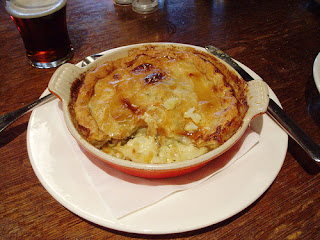
A Jerusalem artichoke pie.
Photograph courtesy of Ewan Munro.
www.flickr.com/photos/55935853@N00/2875124213/
Noix de Saint-Jacques de Plongée, Panais, Topinambours et Salsifis – The meat of the king scallop, collected by divers. The scallop meat will have been very lightly fried and is served with parsnips, Jerusalem artichokes, and salsify. Diving for scallops saves the ocean floor. Fishing boats seeking scallops use dredges that destroy the seafloor, the source of food for many fish. The vegetable salsify is not well known outside mainland Europe. Salsify also called the oyster plant, is a root vegetable both cultivated and found growing wild near seashores. There are two types of salsify, but they taste the same. At some point in time, someone thought its texture or taste was like an oyster. I have enjoyed salsify and oysters separately on more than a few occasions, and I could not associate the texture or taste of salsify with oysters. Salsify's taste is somewhat similar to asparagus, and well-cooked its texture will be similar to other well-cooked root vegetables. In this menu listing, the scallops are identified as "Noix de Saint Jacques," indicating that only the scallop's meat will be served. The scallop's attractive shell will not be part of the dish.
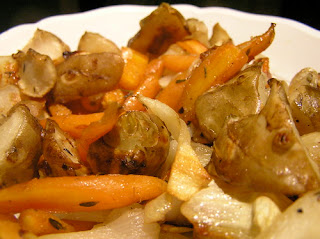
Carrots, onions, and Jerusalem artichokes
Photograph courtesy of Laurel
F
www.flickr.com/photos/laurelfan/3178422475/
Veloute de Panais et Topinambour – A velvety soup of parsnips and the Jerusalem artichoke.
Where the Jerusalem artichoke originated.
The Jerusalem artichoke originated in North America, where it still grows wild. That is a long way from Jerusalem in the Middle East. The French colonists in Canada learned about these tubers from Native Americans and immediately began to cultivate them. They also sent plants back home to France. The Jerusalem artichoke is related to the sunflower, and when you see their flowers, you will make the connection.
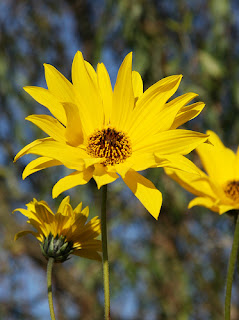
The flowers of the Jerusalem
artichoke.
Photograph courtesy of Maja
Dumat
www.flickr.com/photos/blumenbiene/5099129005/
Who gave this tuber its two French names,
The Artichauts de Jérusalem and
Topinambour?
How the French Canadian colonists turned this tuber into the Jerusalem artichoke is much disputed. The French blame the Italians; the Italians blame the French. The second name the French Canadians gave is Topinambor which is the name of a Brazilian tribe! When the French were introduced to this plant in the 17th century, there would have been very few Italians walking around in Canada naming plants and no Brazilian tribes.
Some stories link the settlers’ use of the name artichoke to their letters home. There they compared the taste of the cooked tuber to an artichoke heart. However, that does not explain Jerusalem or that Brazilian tribe. There are other stories, but they seem rather farfetched, and I have not included them. The real stories behind the French names for this tuber remain a mystery, and whatever the reasoning behind the various names, this tuber is very tasty.
The Jerusalem artichoke, the topinmabor, in the languages of France’s neighbors:
(Catalan - pataca or patata de canya),(Dutch - topinamboer, knolzonnebloem of Jeruzalemartisjok), (German - topinambur), (Italian – tupinambur, patata del Canadà, carciofo di Gerusalemme), (Spanish - tupinambo, pataca).
----------
Behind the French Menu
by
Bryan G. Newman
Copyright
2010, 2015, 2021
behindthefrenchmenu@gmail.com
--------------------------------
Searching
for the meaning of words, names or phrases
on
a
French menu?
Just add the word, words, or phrase that you are searching for to the words "Behind the French Menu" (best when including the inverted commas), and search with Google. Behind the French Menu’s links, include hundreds of words, names, and phrases that are seen on French menus. There are over 450 articles that include over 4,000 French dishes with English translations and explanations.
Connected posts:
Ail - Garlic. Garlic in French Cuisine.
Argenteuil, its Famous Asparagus, and its even more Famous Painters
Artichokes on French Menus. Artichauts in French.
Chateaubriand Steak and Chateaubriand the Man. Ordering a Chateaubriand steak in France.
Ciboulette – Chives, the herb, in French Cuisine.
Filet Mignon on French Menus and Filet de Bœuf in French Cuisine.
Gingembre – Ginger, the Spice. Ginger is very important in French Cuisine, and Gingerbread is Very Popular.
Huitres - Oysters I. Ordering, Eating, and Enjoying Oysters in France.
Jus – Fruit or Vegetable Juice and/or a cooked dish’s natural juices on French Menus.
Salsifis – The Salsify or Oyster Plant on French Menus. The Salsifis in French Cuisine.
Soup on the French Menu. A Soup by Any Other Name, but France has So Many Names for Soup.
The Cardoon, in French the Cardon. A Vegetable That you May Not of Heard of.
The King Scallop and the Queen Scallop. On French Menus the Saint-Jacque, the Coquilles Saint-Jacques and the Vanneaux or Pétoncle.
Thyme in France. Thym, Serpolet, Farigoule and Thym Citron, Lemon Thyme in France.
Tournedos Rossini, after 150 years still the most famous of all steak dishes.
Turnips, (Navets) Parsnips (Panais) and Swedes (Chou-Navets or Rutabaga). Traditional Root Vegetables in Modern French Cuisine.
Veal in France II - Escalope de Veau or Paillard de Veau. A Veal Cutlet, Escalope, Escallop or Scallop.
Velouté Soupe and Sauce Velouté - A Veloute Soup and a Veloute Sauce. - A Velouté is One of France's "Mother" Sauces and one of the Many Styles of Soups and Sauces on French Menus.







